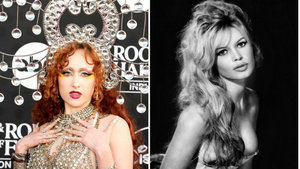In an exclusive excerpt from his new book,
Hollywood Bohemians: Transgressive Sexuality and the Selling
of the Movieland Dream, Brett L. Abrams explores
the relationship between Cary Grant and Randolph
Scott, who led homosexual lives right under
everyone's nose.
Newspaper and
magazine articles, Hollywood novels, and Hollywood movies
featuring Hollywood between the late 1910s and early 1940s
showed audiences homosexuals, adulterers, effeminate
males, and butch females. Actress Greta Garbo defined
herself as a bachelor. Screenwriter Mercedes De Acosta
wore mannish attire. A trio of male heartthrobs attended a
party and showed no romantic interest in women. Homosexual
designers picked up men in nightclubs. The industry
and the media covering Hollywood developed and
disseminated these real and fictional characters, whom
I call Hollywood's bohemians.
The Hollywood
bohemians appeared because they contributed significantly
to the construction of the movie capital's image.
They helped forge the perspective of Hollywood as the
most racy, risque and unconventional place in the
country. Hollywood was the dream factory, a place to project
our fantasies and reflect our dreams, no matter how
outlandish. The usual Hollywood publicity enabled
audience members to develop a sense of intimacy with
the celebrity so that readers could imagine themselves as
having a greater understanding of the star.
Hollywood
bohemian images increased the appeal to audiences'
prurient interests with sexual naughtiness. As
homosexuals, adulterers, effeminate males, and butch
females, the bohemians embodied the pleasures of the
forbidden and the taboo. Hollywood bohemians linked the
industry to exposure of (previously) guarded secrets.
They played an important role in developing
Hollywood's image as a place of sexual abandon,
further enhancing the Hollywood
"mystique." The brilliance of these images was
that they set the bohemians at familiar Hollywood locations.
The presence of the sexual "other" makes
the location more exciting, and the familiar location
makes the "other" less threatening.
The bohemians are
the forerunners of today's highly sexualized images.
They highlighted celebrity and public figures'
personal lives, which has become the focus of
extensive coverage now. They represent an early
example of the media presenting culturally controversial
behavior images to attract audiences.
The first
publicity images containing information about Grant and
Scott began after they became friends while filming
the movie Hot Saturday in mid-1932.
Press reports during the first two years described the
actors' shared celebrity home and domestic life
through phrases including, "Hollywood's
twosome" and "the happy couple." The
innuendos provided details about the two actors'
personal lives which thrilled fans, making the actors
appear to be two men sharing more than lodgings.
Other articles
attempted to understand the actors' living
arrangements in other ways, such as the need to reduce
rental costs. These items noted that similar to other
single men, the actors shared lodgings earlier in
their lives when they struggled to make it in the arts.
However, by 1935 they had little financial incentive
to continue having roommates for this reason. Cary
Grant's continued use of finances as the explanation
for his living arrangement inadvertently revealed a
deeper truth. "'Here we are,'
Cary would say, leaning back in a chair, 'living as
we want to as bachelors with a nice home at a
comparatively small cost. If we got married, we would
have to put up a front. Women -- particularly Hollywood
women -- expect it."
Grant expressed
that he and Scott lived as they wanted to: as bachelors,
together within a nice home. The actor used the word
"front" to mean that if he and Scott got
married, the industry would require them to spend
money and put on airs. However, his word choice had the
double meaning: once they each married, Grant and
Scott would be putting up a front that hid their
desire to live together.
The pair
continued their domestic relationship even after
Grant's marriage to Virginia Cherrill in early
1934. Reporters noted, "The Grants and Randolph
Scott have moved, all three, but not apart." Indeed,
this choice for living arrangements appeared
preplanned. An item from two weeks prior to
Grant's marriage observed that Scott would not seek
any permanent quarters until he heard from Grant.
Innuendos continued later that year. Shortly after
Grant's divorce from Cherrill, an article
proclaimed that Randolph Scott had moved back in with Grant.
This article's title, "A Woman Is Only a
Woman," suggested that the two men formed a
home life with one another that they probably could not have
with a woman. These items associated the actors' home
with a forbidden sexuality, turning the place into an
exotic experience.
There were few
images of two men living together in popular culture,
literature, or medical textbooks during this era. Many
movies had strong male comradeship themes, but the men
did not share a house. In these movies, a group of men
bonded by accomplishing some "manly" act, such
as going off to war or conquering the wilderness. Even
the medical community members who wrote about their
studies of homosexuals very rarely included case
studies of two men who lived together. One of the few
instances of an image of men living together appeared
in Richard Meeker's Better Angel, a 1933
novel about homosexuals. Its protagonist Kurt stayed in
effeminate David's apartment before Kurt decided to
commit to his relationship with David.
The Paramount
publicity department shot over thirty photographs of Grant
and Scott within different rooms of their Santa Monica beach
house. The studio focused its interpretation of these
pictures on the stars' personalities,
bachelorhood, and use of the house. The caption stamped on
the back of each photograph highlighted that the actors were
two of filmland's most eligible bachelors who
shared quarters but lived independent lives.
The studio
believed that photographs of the actors using their swimming
pool and sitting at their den bar revealed each man's
physical attractiveness. The images also showed the
men's fun-loving spirits within a luxurious and
beautiful place. The studio presumably thought that
the photographic series depicted each man as a swinging
Hollywood bachelor. These images appealed to both
heterosexually inclined women who appreciated the
actors' looks, domesticity, or both, and to
heterosexually inclined men, who saw the men living a
fantasy "high life."
These groups were
not the only people to whom the photographic series
appealed. Other photographs in the series heightened the
unusualness of their star home by illustrating the
actors' Hollywood bohemian natures. In three
photographs of the pair at the dining room table each man
stared and smiled across the table at one another. In
another set, Grant leaned over the seated
Scott's shoulder and appeared to watch him write out
a note or bill. The photographs demonstrated that the
actors found the space and the homey atmosphere
comfortable while they displayed a degree of shared
intimacy with one another that people expected to find in a
romantic heterosexual couple.
The photograph
that depicted the end of this long day was the most
suggestive that the actors were Hollywood bohemians sharing
a loving relationship. Scott and Grant stood on their
patio in the early evening. They appeared in
silhouette, as Pacific Ocean waves crested behind them.
Scott touched his lit cigarette against the cigarette
dangling from Grant's mouth.
The presentation
of two men smoking together appeared frequently in
fiction during the era. However, these scenes occurred in
bars, saloons, and other "masculine"
spaces rather than in a space that the culture viewed
as romantic. The interaction between the two men did not
present them as a pair, isolated from everyone around
them. One man rarely lit the other man's
cigarette, and certainly did not lean forward to light a
cigarette as it dangled from the other man's mouth.
The image of a male and female couple lighting
cigarettes within a beautiful night scene at home
appeared most frequently in cigarette advertising since the
mid-1920s. These images linked smoking cigarettes to
romance.
Scott and Grant
appeared within that similar type of romantic setting.
One lit the
other's cigarette as the man lit a woman's
cigarette for her in the advertisements and popular
culture of the era. Scott gingerly touched the
cigarette as it dangled from Grant's mouth,
demonstrating a comfort with close physical proximity.
This photograph hinted at a shared intimacy between
the actors. This image took the viewer inside the
actors' private dwelling and linked the house to a
forbidden sexuality and pleasure. While depicting the
taboo, it also showed that behavior in a remarkably
touching and beautiful way that made the home even more
memorable. This image also illuminated a type of coupling
within a home that few readers would have seen, making
this star home appear bohemian and highly unique. The
actors' living arrangement lasted until early 1942
when they moved apart for the remainder of their lives.
From Hollywood
Bohemians: Transgressive Sexuality and the Selling
of the Movieland Dream (c) 2008 Brett L. Abrams
by permission of McFarland & Company Inc., Box
611, Jefferson NC 28640. www.mcfarlandpub.com




































































Charlie Kirk DID say stoning gay people was the 'perfect law' — and these other heinous quotes